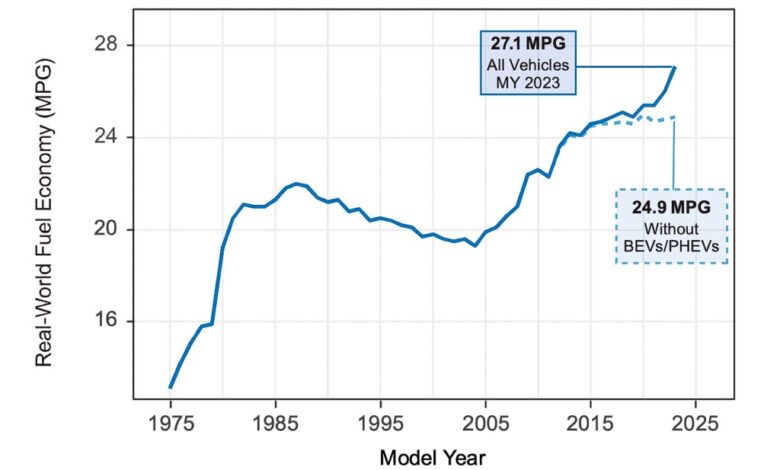EPA celebrates the 50th Anniversary of its Automotive Trends Report

Since the passage of the Clean Air Act in 1970, the Environmental Protection Agency has worked collaboratively with the automotive industry to reduce air pollution from light duty vehicles. This year marks the 50th anniversary of the EPA’s Automotive Trends Report, an annual publication that explains the agency’s complex regulatory framework and documents the compliance of individual automakers. The authoritative report features a comprehensive dataset on every light duty vehicle sold in the United States since 1975and provides sophisticated analysis of the major trends shaping the industry’s environmental outcomes.
The 2024 report includes finalized data from the 2023 model year and is prefaced by a letter from EPA Administrator Michael Regan acknowledging the 50-year milestone. The congratulatory statement honors the agency’s career professionals, highlighting achievements that “ultimately led to an impressive 99 percent reduction of common vehicle tailpipe pollutants, such as hydrocarbons, carbon monoxide, nitrogen oxides and particulate matter.” The letter goes on to emphasize the scientific value of the dataset as the auto industry struggles to mitigate tailpipe carbon dioxide, an inevitable byproduct of gasoline combustion and a substantial contributor to climate change.
Carbon dioxide emissions are now the primary focus of the report, and the latest statistics provide a bit of encouraging news. The average light duty vehicle from model year 2023 produced 319 grams of carbon dioxide per mile (g/mi), an 18-g/mi improvement over model year 2022. The respectable reduction in tailpipe emissions corresponded to a year over year fuel economy gain of 1.1 MPG, with the average 2023 vehicle getting 27.1 miles to the gallon.
The fifty-year history of real-world fuel economy trends can be divided into three distinct periods. Between 1975 and 1987, fuel economy improved rapidly as the United States responded to the Arab oil embargo, rising from 13.1 MPG to 22.0 MPG. When concerns about energy independence faded during the late eighties, gas mileage began a slow descent, dropping steadily to a low of 19.3 MPG in 2004. A strong upward trend emerged in 2005 as growing apprehension about climate change catalyzed a relentless effort to mitigate tailpipe carbon dioxide. The 2023 figures for MPG and CO2 emissions are the latest in a string of all-time records that began in 2009.
The EPA attributes most of the recent progress to increased production of battery electric vehicles and plug-in hybrid electric vehicles. When BEVs and PHEVs are statistically removed from the 2023 model year fleet, average CO2 emissions rise to 357 g/mi and average fuel economy drops to 24.9 MPG. These hypothetical averages are identical to the finalized outcomes from the 2017 model year. Automotive technologies that increase the fuel economy of conventional internal combustion vehicles are being undermined by consumer trends favoring larger, more powerful models, and it will be challenging to improve their efficiency much further.
The 50th Anniversary of the Automotive Trends Report coincides with a dawning era of environmental innovation. Maintaining progress against carbon dioxide will now depend on increasing the proliferation of our cleanest powertrains, and there are good reasons to be hopeful as we reflect on the promising outcomes from 2023.




